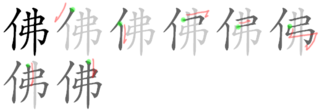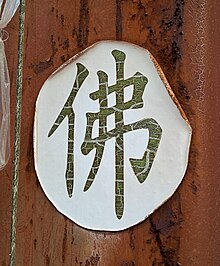佛
Translingual
| Stroke order | |||
|---|---|---|---|

| |||
Han character
佛 (Kangxi radical 9, 人+5, 7 strokes, cangjie input 人中中弓 (OLLN), four-corner 25227, composition ⿰亻弗)
Derived characters
References
- Kangxi Dictionary: page 99, character 4
- Dai Kanwa Jiten: character 517
- Dae Jaweon: page 208, character 11
- Hanyu Da Zidian (first edition): volume 1, page 140, character 3
- Unihan data for U+4F5B
Chinese
| simp. and trad. |
佛 | |
|---|---|---|
| alternative forms | ||
Glyph origin
| Historical forms of the character 佛 | |
|---|---|
| Shuowen Jiezi (compiled in Han) | Liushutong (compiled in Ming) |
| Small seal script | Transcribed ancient scripts |

|

|
|
References:
Mostly from Richard Sears' Chinese Etymology site (authorisation),
| |
Phono-semantic compound (形聲/形声, OC *bɯd) : semantic 亻 + phonetic 弗 (OC *pɯd).
Etymology 1
Abbreviation of 佛陀 (MC bjut da), from Pali buddha or Sanskrit बुद्ध (buddha, “awakened; enlightened”).
Pronunciation
- Mandarin
- (Standard)
- (Chengdu, Sichuanese Pinyin): fu2
- (Dungan, Cyrillic and Wiktionary): фә (fə, I)
- Cantonese
- Gan (Wiktionary): fiit7 / fiit6
- Hakka
- Jin (Wiktionary): feh5
- Northern Min (KCR): hō
- Eastern Min (BUC): hŭk
- Southern Min
- Wu (Shanghai, Wugniu): 5veq
- Xiang (Changsha, Wiktionary): fu6
- Mandarin
- (Standard Chinese)+
- Hanyu Pinyin:
- Zhuyin: ㄈㄛˊ
- Tongyong Pinyin: fó
- Wade–Giles: fo2
- Yale: fwó
- Gwoyeu Romatzyh: for
- Palladius: фо (fo)
- Sinological IPA (key): /fu̯ɔ³⁵/
- (Chengdu)
- Sichuanese Pinyin: fu2
- Scuanxua Ladinxua Xin Wenz: fu
- Sinological IPA (key): /fu²¹/
- (Dungan)
- Cyrillic and Wiktionary: фә (fə, I)
- Sinological IPA (key): /fə²⁴/
- (Note: Dungan pronunciation is currently experimental and may be inaccurate.)
- (Standard Chinese)+
- Cantonese
- (Standard Cantonese, Guangzhou–Hong Kong)
- Jyutping: fat6
- Yale: faht
- Cantonese Pinyin: fat9
- Guangdong Romanization: fed6
- Sinological IPA (key): /fɐt̚²/
- (Taishanese, Taicheng)
- Wiktionary: fut5
- Sinological IPA (key): /fut̚³²/
- (Standard Cantonese, Guangzhou–Hong Kong)
- Gan
- (Nanchang)
- Wiktionary: fiit7 / fiit6
- Sinological IPA (key): /fɨt̚²/, /fɨt̚⁵/
- (Nanchang)
- Hakka
- (Sixian, incl. Miaoli and Meinong)
- Pha̍k-fa-sṳ: fu̍t
- Hakka Romanization System: fud
- Hagfa Pinyim: fud6
- Sinological IPA: /fut̚⁵/
- (Meixian)
- (Sixian, incl. Miaoli and Meinong)
- Jin
- (Taiyuan)+
- Wiktionary: feh5
- Sinological IPA (old-style): /fəʔ⁵⁴/
- (Taiyuan)+
- Northern Min
- (Jian'ou)
- Kienning Colloquial Romanized: hō
- Sinological IPA (key): /xo⁵⁵/
- (Jian'ou)
- Eastern Min
- (Fuzhou)
- Bàng-uâ-cê: hŭk
- Sinological IPA (key): /huʔ⁵/
- (Fuzhou)
- Southern Min
- Xiamen, Quanzhou, Taiwan:
- pu̍t - vernacular;
- hu̍t - literary.
- Dialectal data
| Variety | Location | 佛 |
|---|---|---|
| Mandarin | Beijing | /fo³⁵/ |
| Harbin | /fɤ²⁴/ | |
| Tianjin | /fo⁴⁵/ | |
| Jinan | /fə⁴²/ | |
| Qingdao | /fu⁴²/ | |
| Zhengzhou | /fu⁴²/ | |
| Xi'an | /fo²⁴/ | |
| Xining | /fɔ²⁴/ | |
| Yinchuan | /fu¹³/ /fuə⁵³/ | |
| Lanzhou | /fə⁵³/ | |
| Ürümqi | /fɤ⁵¹/ | |
| Wuhan | /fu²¹³/ | |
| Chengdu | /fu³¹/ /fəu³¹/ | |
| Guiyang | /fu²¹/ | |
| Kunming | /fu³¹/ | |
| Nanjing | /fuʔ⁵/ | |
| Hefei | /fəʔ⁵/ | |
| Jin | Taiyuan | /fəʔ⁵⁴/ |
| Pingyao | /xuʌʔ⁵³/ | |
| Hohhot | /fɤ³¹/ | |
| Wu | Shanghai | /vəʔ¹/ |
| Suzhou | /vəʔ³/ | |
| Hangzhou | /vəʔ²/ | |
| Wenzhou | /vai²¹³/ | |
| Hui | Shexian | /fu²²/ |
| Tunxi | /fə¹¹/ | |
| Xiang | Changsha | /fu²⁴/ |
| Xiangtan | /ɸu⁵⁵/ | |
| Gan | Nanchang | /fɨʔ²/ |
| Hakka | Meixian | /fut̚⁵/ |
| Taoyuan | /fut̚⁵⁵/ | |
| Cantonese | Guangzhou | /fɐt̚²/ |
| Nanning | /fɐt̚²²/ | |
| Hong Kong | /fɐt̚²/ | |
| Min | Xiamen (Hokkien) | /hut̚⁵/ /put̚⁵/ |
| Fuzhou (Eastern Min) | /huʔ⁵/ | |
| Jian'ou (Northern Min) | /xo⁴⁴/ /xu²⁴/ | |
| Shantou (Teochew) | /huk̚⁵/ | |
| Haikou (Hainanese) | /ʔbut̚³/ |
- Middle Chinese: bjut
- Old Chinese
- (Baxter–Sagart): /*[b][u]t/
- (Zhengzhang): /*bɯd/
Definitions

- (Buddhism) Buddha
- (Buddhism) statue of Buddha
- (by extension) Buddhist scriptures
- (by extension) Buddhism; Buddhist doctrines
Descendants
Others:
- → Mongolian: ᠪᠤᠷᠬᠠᠨ (burqan) / бурхан (burxan)
- Lua error in Module:etymology/templates/descendant at line 287: You specified a term in 4= and not one in 3=. You probably meant to use t= to specify a gloss instead. If you intended to specify two terms, put the second term in 3=.
- → Zhuang: baed
Compounds
Lua error in Module:zh/templates at line 32: This template has been deprecated. Please use Template:col3 instead.
Etymology 2
| For pronunciation and definitions of 佛 – see 彿. (This character is the simplified and variant traditional form of 彿). |
Notes:
|
Etymology 3
Pronunciation
- Mandarin
- (Standard Chinese, Mainland)+
- Hanyu Pinyin:
- Zhuyin: ㄈㄨˊ
- Tongyong Pinyin: fú
- Wade–Giles: fu2
- Yale: fú
- Gwoyeu Romatzyh: fwu
- Palladius: фу (fu)
- Sinological IPA (key): /fu³⁵/
- (Standard Chinese, Taiwan)+
- Hanyu Pinyin:
- Zhuyin: ㄈㄛˊ
- Tongyong Pinyin: fó
- Wade–Giles: fo2
- Yale: fwó
- Gwoyeu Romatzyh: for
- Palladius: фо (fo)
- Sinological IPA (key): /fu̯ɔ³⁵/
- (Standard Chinese, Mainland)+
- Cantonese
- (Standard Cantonese, Guangzhou–Hong Kong)
- Jyutping: fat1
- Yale: fāt
- Cantonese Pinyin: fat7
- Guangdong Romanization: fed1
- Sinological IPA (key): /fɐt̚⁵/
- (Standard Cantonese, Guangzhou–Hong Kong)
Definitions
- † (deprecated template usage) Alternative form of 拂 (fú, “to go against; to be contrary to”).
Compounds
Lua error in Module:zh/templates at line 32: This template has been deprecated. Please use Template:col3 instead.
Etymology 4
Pronunciation
- Mandarin
- (Standard Chinese)+
- Hanyu Pinyin:
- Zhuyin: ㄅㄧˋ
- Tongyong Pinyin: bì
- Wade–Giles: pi4
- Yale: bì
- Gwoyeu Romatzyh: bih
- Palladius: би (bi)
- Sinological IPA (key): /pi⁵¹/
- (Standard Chinese)+
- Cantonese
- (Standard Cantonese, Guangzhou–Hong Kong)
- Jyutping: bat6
- Yale: baht
- Cantonese Pinyin: bat9
- Guangdong Romanization: bed6
- Sinological IPA (key): /pɐt̚²/
- (Standard Cantonese, Guangzhou–Hong Kong)
Definitions
- † (deprecated template usage) Alternative form of 弼 (bì, “to assist”).
- 佛時仔肩,示我顯德行。 [Pre-Classical Chinese, trad.]
- From: The Classic of Poetry, c. 11th – 7th centuries BCE, translated based on James Legge's version
- Bì shí zǐjiān, shì wǒ xiǎn déxíng. [Pinyin]
- Assist me to bear the burden [of my position],
And show me how to display a virtuous conduct.
佛时仔肩,示我显德行。 [Pre-Classical Chinese, simp.]
- a surname
Etymology 5
Pronunciation
- Mandarin
- (Standard Chinese)+
- Hanyu Pinyin:
- Zhuyin: ㄅㄛˊ
- Tongyong Pinyin: bó
- Wade–Giles: po2
- Yale: bwó
- Gwoyeu Romatzyh: bor
- Palladius: бо (bo)
- Sinological IPA (key): /pu̯ɔ³⁵/
- (Standard Chinese)+
- Cantonese
- (Standard Cantonese, Guangzhou–Hong Kong)
- Jyutping: but6
- Yale: buht
- Cantonese Pinyin: but9
- Guangdong Romanization: bud6
- Sinological IPA (key): /puːt̚²/
- (Standard Cantonese, Guangzhou–Hong Kong)
Definitions
- † (deprecated template usage) Alternative form of 勃 (bó, “prosperous; thriving”).
Japanese
| 仏 | |
| 佛 |
Kanji
(Jinmeiyō kanji, kyūjitai kanji, shinjitai form 仏)
Readings
Korean
Hanja
Compounds
Vietnamese
Han character
佛: Hán Việt readings: phật (
佛: Nôm readings: phật[1][2][3][4][6]
Compounds
References
- Translingual lemmas
- Translingual symbols
- Han script characters
- Han phono-semantic compounds
- Chinese terms derived from Pali
- Chinese terms derived from Sanskrit
- Chinese lemmas
- Mandarin lemmas
- Sichuanese lemmas
- Dungan lemmas
- Cantonese lemmas
- Taishanese lemmas
- Gan lemmas
- Hakka lemmas
- Jin lemmas
- Northern Min lemmas
- Eastern Min lemmas
- Hokkien lemmas
- Teochew lemmas
- Wu lemmas
- Xiang lemmas
- Middle Chinese lemmas
- Old Chinese lemmas
- Chinese hanzi
- Mandarin hanzi
- Sichuanese hanzi
- Dungan hanzi
- Cantonese hanzi
- Taishanese hanzi
- Gan hanzi
- Hakka hanzi
- Jin hanzi
- Northern Min hanzi
- Eastern Min hanzi
- Hokkien hanzi
- Teochew hanzi
- Wu hanzi
- Xiang hanzi
- Middle Chinese hanzi
- Old Chinese hanzi
- Chinese proper nouns
- Mandarin proper nouns
- Sichuanese proper nouns
- Dungan proper nouns
- Cantonese proper nouns
- Taishanese proper nouns
- Gan proper nouns
- Hakka proper nouns
- Jin proper nouns
- Northern Min proper nouns
- Eastern Min proper nouns
- Hokkien proper nouns
- Teochew proper nouns
- Wu proper nouns
- Xiang proper nouns
- Middle Chinese proper nouns
- Old Chinese proper nouns
- Chinese nouns
- Mandarin nouns
- Sichuanese nouns
- Dungan nouns
- Cantonese nouns
- Taishanese nouns
- Gan nouns
- Hakka nouns
- Jin nouns
- Northern Min nouns
- Eastern Min nouns
- Hokkien nouns
- Teochew nouns
- Wu nouns
- Xiang nouns
- Middle Chinese nouns
- Old Chinese nouns
- Chinese terms with IPA pronunciation
- Chinese terms spelled with 佛
- zh:Buddhism
- Mandarin terms with usage examples
- Chinese simplified forms
- Chinese variant forms
- Mandarin terms with multiple pronunciations
- Chinese verbs
- Mandarin verbs
- Cantonese verbs
- Chinese terms with obsolete senses
- Literary Chinese terms with quotations
- Chinese surnames
- Chinese adjectives
- Mandarin adjectives
- Cantonese adjectives
- zh:Religion
- Japanese kanji
- Japanese jinmeiyō kanji
- Japanese kanji with goon reading ぶつ
- Japanese kanji with kan'on reading ふつ
- Japanese kanji with kun reading ほとけ
- Japanese kanji with nanori reading さらぎ
- Korean lemmas
- Korean hanja
- Vietnamese Chữ Hán
- Vietnamese lemmas
- Vietnamese Han characters
- Vietnamese Nom

